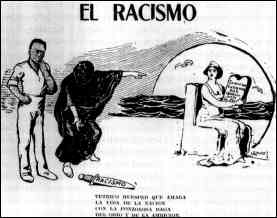
Empire Uses of Race Fear in Cuba
One of the methods used by the Spanish empire to contain their last colonies in the new world was to emphasize and exaggerate the racism that had existed for centuries. This racism had not only allowed the slave trade, but profited well from it and attempted to prolong it. Now, this tradition of racism would help the empire to maintain the status quo in the Americas.

Shortly after the Haiti slave revolts of 1794, the Spaniards saw a way to discourage whites from joining the growing movement for independence and separation. The many white slave owners who emigrated from Haiti were full of horror stories about black on white violence, and this became the main threat in a campaign of fear.
The threat to whites was embodied in three specific stereotypical ideas that defined Afro-Cubans to white society. These images emerged subtly and blatantly in government documents and rhetoric, art, theater and music, newspaper stories and editorials, idle chat and academic discussions. The three basic stereotypical fears are: 1. Race war, 2. African religion and culture, 3. Afro-Cuban sexuality.
Fear #1 - Race War (The Haitian Revolution)
The idea of an Afro-Cuban uprising was used successfully to dissuade Cubans from joining the rebel cause during the various wars of independence. This worked to bring the Ten Year War to a stalemate end in 1878, after various campaigns against Antonio Maceo, who was portrayed as a potential dictator who would slaughter whites once the Empire was out of Cuba.
The campaign against Maceo was not limited to Spanish propaganda. White rebel leaders, surprised and afraid of his popularity and acceptance among all Cubans, brought the Ten Year War to a stalemate end.
Fear #2 - African Religion and Culture
It was often suggested that Afro-Cuban culture was limited to magic, witchcraft, criminality, and even anthropology. Allowing Afro-Cubans to positions of power would lead to the total replacement or corruption of "western" Cuban culture with African culture. The black brujo (male witch) and the black ñáñigo (member of a secret, male only society of African origin known as Abakuá societies) were exaggerated by Spanish culture to imply something of lower class and un-Godly values.
The first Abakuá society is believed to have appeared in 1836 Havana, with a direct origin traceable to the Niger Delta. Spanish culture and rhetoric associated these societies to crime, murder, harmful magic and brutal, barbaric behavior. Of course, these had nothing to do with what these societies were all about.
Fear #3 - Afro-Cuban Sexuality
The black man was portrayed as a rapist of white women. Mulatto women were devious and seductive, and black women were portrayed as lustful and untrustworthy. If left to their own devices, Afro-Cubans would revert to animalistic behavior.
- -
These stereotypes were used in varying forms to separate the Cuban population and bring about more "Spanish" values.
[For a more detailed exploration of the empire uses of race fear in Cuba, see the book by Aline Helg, "Our Rightful Share: The Afro-Cuban Struggle for Equality, 1886-1912."]
Race in Cuba
Opening | Introduction | End of
Slavery | Race Fear | After the War | SUGAR | Race War |
Race War Timeline |
José Miguel
Gómez | Morúa Delgado
| Fernando Ortíz |
Julián Valdés Sierra |
Oriente Province |
Martí on Race |
Bibliography